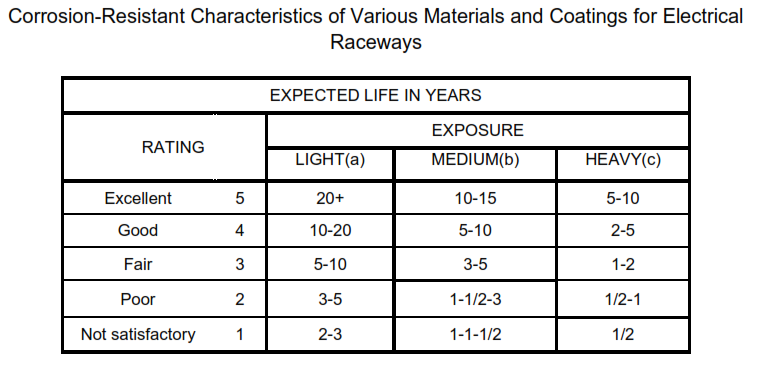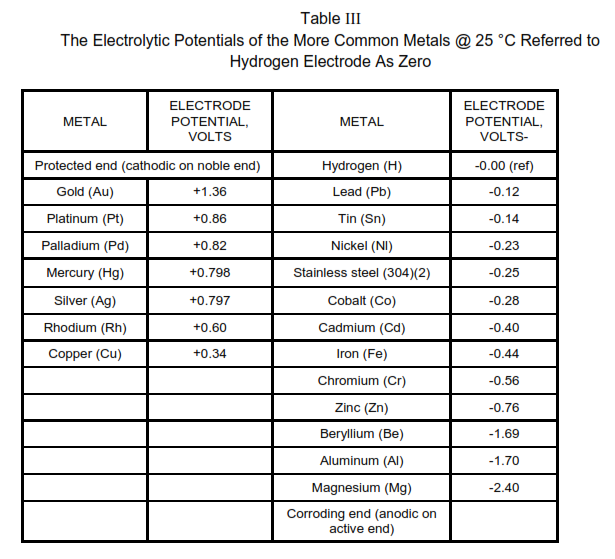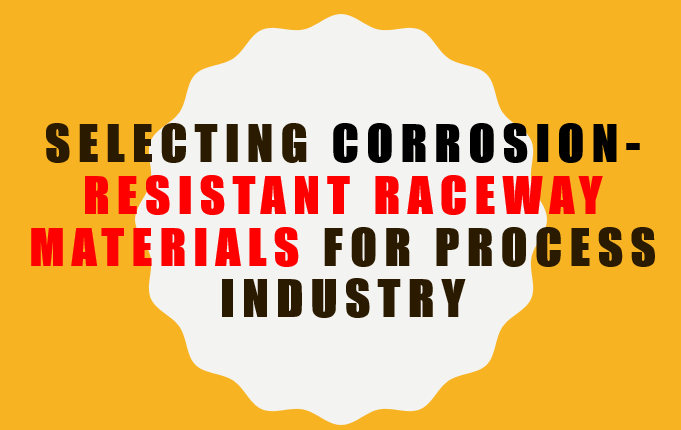Selecting Corrosion-resistant Raceway Materials for Process Industry
(a) Light – Outdoor location with occasional atmospheric contamination within human tolerance. No spills of corrosive agent. Wiring system subject only to washing by rain.
(b) Medium – Environmental atmosphere containing vapors within range of continuous human tolerance. Occasionally splashing or spills of corrosive agent averaging once a month. Subject to occasional washdown.
(c) Heavy – Environmental atmosphere containing vapors which are continuously, intermittently, or periodically beyond range of human tolerance. Frequent splashing or spills of corrosive agent averaging twice a week. Subject to washdown twice a week or more frequently.
- Wiring raceway materials selected for a specific project installation should be able to resist the corrosive conditions encountered with a reasonable amount of maintenance and replacement. Each corrosive location has its peculiar set of conditions. The determination of which corrosion-resistant material, coating, or treatment that is adequately effective and reasonably economical depends upon the cause and severity of corrosion. Fittings used with various raceway materials should not only be resistant to the corrosive element but relatively free of galvanic corrosion resulting from combinations of active metals.
- In general, cast iron resists corrosion from alkalies, organic compounds, neutral and slightly acid solutions. It is attacked by almost all common acids of dilute and intermediate strengths, particularly in the presence of dissolved air or other oxidizing agents, and at elevated temperatures. In concentrated acids, and neutral brines, it develops a protective coating of its own corrosive products. Cast iron fittings plated with zinc and cadmium will combat most corrosive elements by neutralizing the penetration of corrosive substances.
- Steel repels the same corrosive chemicals to approximately the same degree as cast iron, however, it incurs more deleterious effects. Whereas ferrous castings arrest oxidation by developing protecting surface coatings, steel progressively oxidizes until rust penetrates its surface. This inherent weakness may be controlled by coating the threads with a suitable conducting-type material.
- When exposed to a number of corrosive conditions, aluminum develops a self-repairing film that, in itself, resists corrosion. However, galvanic corrosion presents a problem, particularly
aluminum alloyed with copper. Without this galvanic agent, aluminum alloys prove effective even when subject to direct salt spray, heavy concentrations of sulphur gases, and
ammonia nitrate. Aluminum alloy successfully combats acetic, citric, and tannic acids.
Generally, copper-free aluminum is not recommended in the presence of the following dilute acids produced by fumes and moisture : formic acid, hydrochloric acid, or chlorine plus moisture, mono- or tri-chloracitic acid, and phosphoric acid. - Brass and silicon bronze have proved indispensable for marine applications. Both metals successfully counteract the corrosive properties of all alkalies except ammonia hydroxide. Silicon bronze more effectively resists salt water, weak acids, dilute hydrochloric acid, sulphuric acids, and sulphur gases. Neither brass nor silicon bronze can withstand ammonia nitrate, phosphorous acid, or ammonia sulphate.
- Copper deteriorates before stronger oxidizing chemicals, for example nitric and highly concentrated sulphuric acids, chlorine, bromine, and ammonia nitrate. Nickel-plated copper resists alkalies.
- Polyethylene and polyvinyl chloride coatings repel corrosion from caustics, alkalies, and heavy mineral acids (hydrochloric and sulphuric). They are not recommended in the presence of formic acid and ketones or esters.
- To combat chemical and galvanic corrosion in electrical wiring raceway installations, consideration should be given to components of conduit fittings, for example metals used in screws, covers, and operating shaft and gasket materials. Suitable materials for such minor parts include stainless steel or cadmium chromate-plated steel screws, synthetic gasket materials, stainless steel, or nylon operating shafts and bushings, aluminum screws and parts for aluminum fittings, and protective lubricants for aluminum threads. Since few gases or vapors entering enclosures are corrosive until they are combined with water, consideration should be given to draining and venting enclosed equipment and raceways.
- See to the list in Table III below for the common metals in galvanic order. Any metal in this list is electropositive to any element preceding it and electronegative to any element following it; however, this arrangement fluctuates with external conditions and cannot serve as an absolute indicator.
- Protecting personnel, buildings, and equipment in hazardous locations, where the vapors or gases are both flammable and corrosive, requires that the electrical equipment and wiring system be both corrosion-resistant and explosion-proof to suit the particular hazardous classification (NEC, Article 500, NEC, Article 501, and NEC, Article 502).


